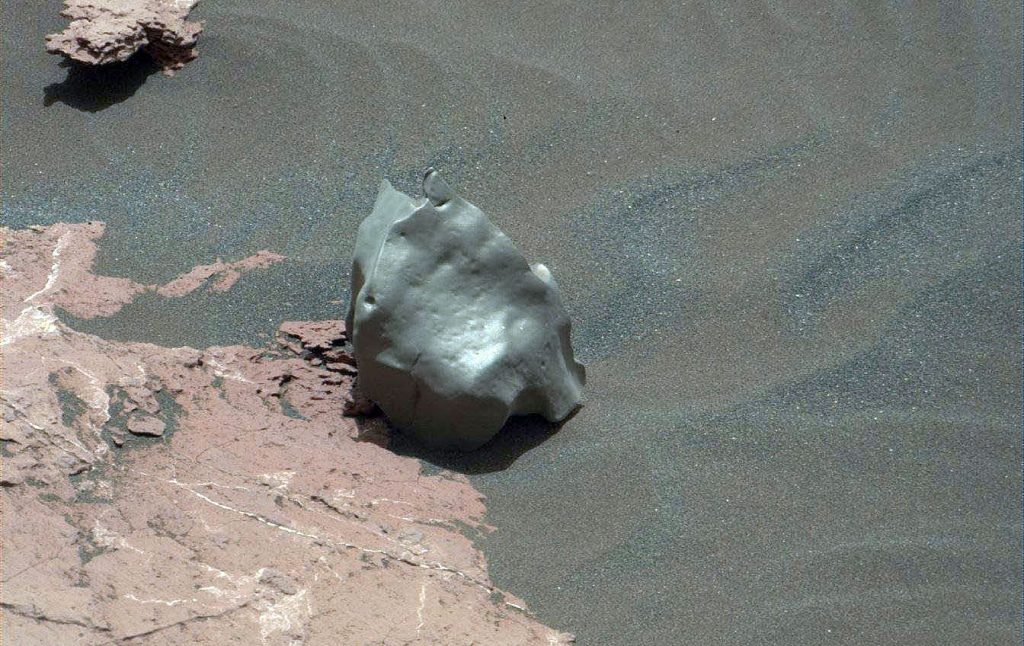
Rolling up the slopes of Mt. Sharp recently, NASA’s Curiosity rover appears to have stumbled across yet another meteorite, its third since touching down nearly four and a half years ago. While not yet confirmed, the turkey-shaped object has a gray, metallic luster and a lightly-dimpled texture that hints of regmaglypts. Regmaglypts, indentations that resemble thumbprints in Play-Doh, are commonly seen in meteorites and caused by softer materials stripped from the rock’s surface during the brief but intense heat and pressure of its plunge through the atmosphere.
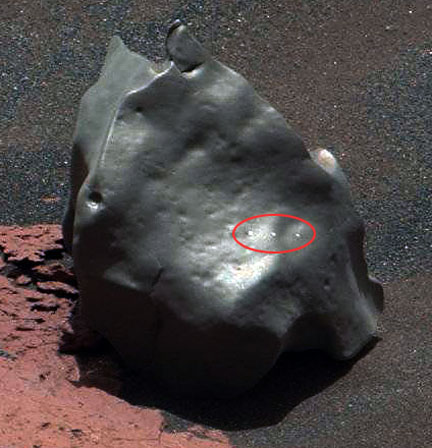
Oddly, only one photo of the assumed meteorite shows up on the Mars raw image site. Curiosity snapped the image on Jan. 12 at 11:21 UT with its color mast camera. If you look closely at the photo a short distance above and to the right of the bright reflection a third of the way up from the bottom of the rock, you’ll spy three shiny spots in a row. Hmmm. Looks like it got zapped by Curiosity’s ChemCam laser. The rover fires a laser which vaporizes part of the meteorite’s surface while a spectrometer analyzes the resulting cloud of plasma to determine its composition. The mirror-like shimmer of the spots is further evidence that the gray lump is an iron-nickel meteorite.
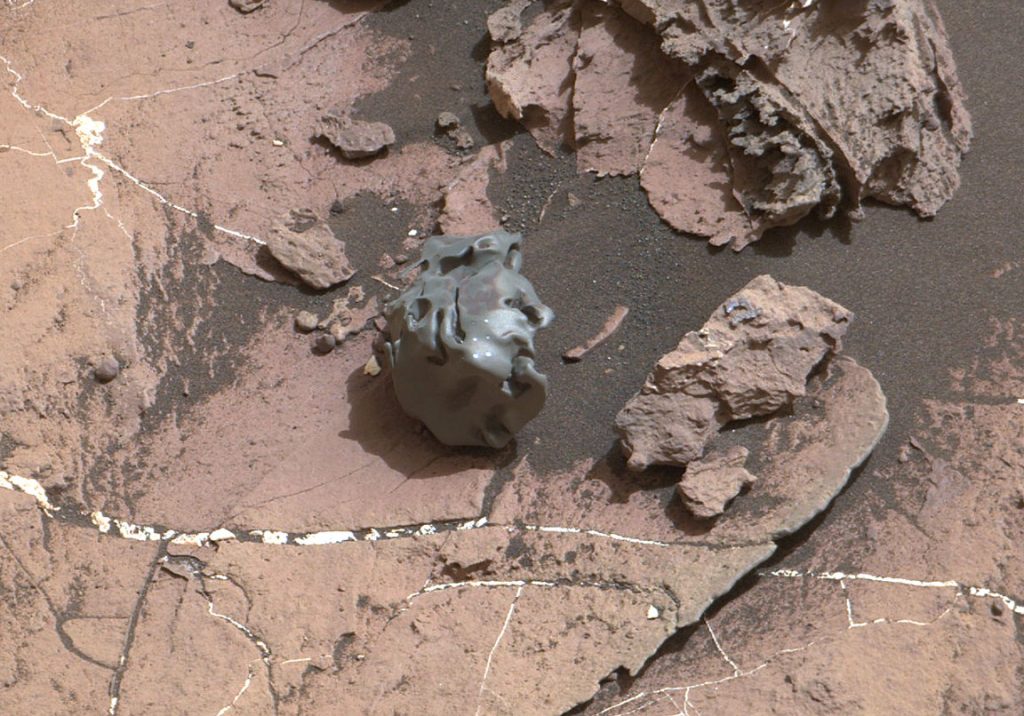
Curiosity has driven more than 9.3 miles (15 km) since landing inside Mars’ Gale Crater in August 2012. It spent last summer and part of fall in a New Mexican-like landscape of scenic mesas and buttes called “Murray Buttes.” It’s since departed and continues to climb to sequentially higher and younger layers of the lower part of Mt. Sharp to investigate additional rocks. Scientists hope to create a timeline of how the region’s climate changed from an ancient freshwater lake environment with conditions favorable for microbial life (if such ever evolved) to today’s windswept, frigid desert.
Assuming the examination of the rock proves a metallic composition, this new rock would be the eighth discovered by our roving machines. All of them have been irons despite the fact that at least on Earth, iron meteorites are rather rare. About 95% of all found or seen-to-fall meteorites are the stony variety (mostly chondrites), 4.4% are irons and 1% stony-irons.

NASA’s Opportunity rover found five metal meteorites, and Curiosity’s rumbled by its first find, a honking hunk of metallic gorgeousness named Lebanon, in May 2014. If this were Earth, the new meteorite’s smooth, shiny texture would indicate a relatively recent fall, but who’s to say how long it’s been sitting on Mars. The planet’s not without erosion from wind and temperature changes, but it lacks the oxygen and water that would really eat into an iron-nickel specimen like this one. Still, the new find looks polished to my eye, possibly smoothed by wind-whipped sand grains during the countless Martian dust storms that have raged over the eons.
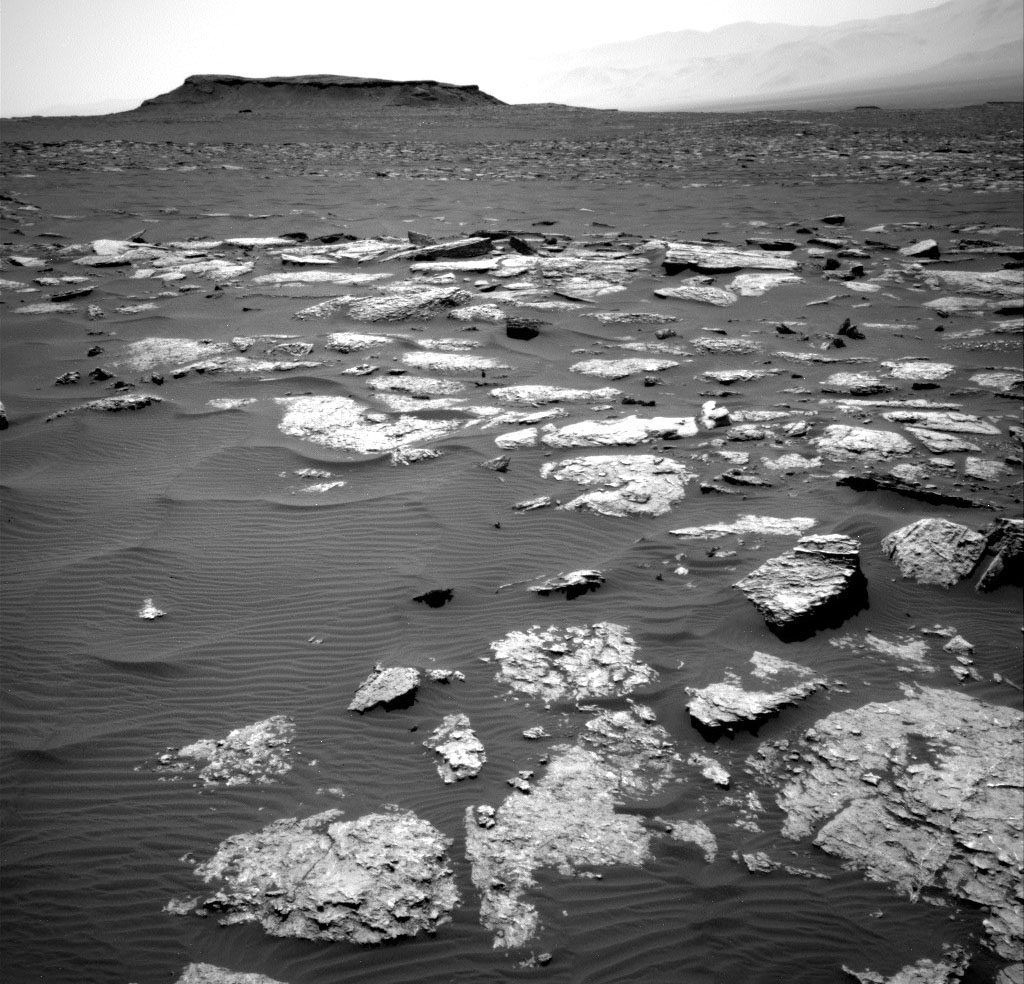
Why no large stony meteorites have yet to be been found on Mars is puzzling. They should be far more common; like irons, stonies would also display beautiful thumprinting and dark fusion crust to boot. Maybe they simply blend in too well with all the other rocks littering the Martian landscape. Or perhaps they erode more quickly on Mars than the metal variety.
Every time a meteorite turns up on Mars in images taken by the rovers, I get a kick out of how our planet and the Red One not only share water, ice and wind but also getting whacked by space rocks.

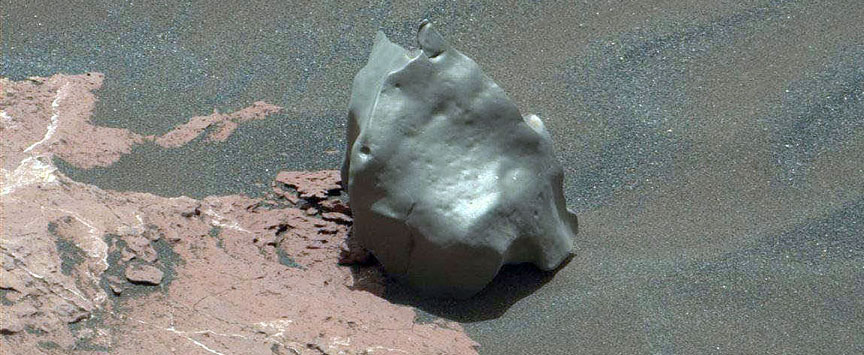
I couldn’t get an idea of scale. Is this new discovery (Sol 1577) a few centimetres across or a few metres?
Ah, found after several re-readings: “golf-ball sized”. (^_^)
Hi tsuchan,
The golf-ball sized meteorite was the one discovered last October. No size is given on this one yet, but I would roughly estimate about 12-15 cm (6-8 inches).
Sci-Fi short story layout as follows: Martian prospectors spread out from the colony searching for NiFe meteors for the smelters. The meteors are turned into structural members of the launch facility and used as building material for expanding the colony. Most of the prospectors use Hydrogen gas inflated solar electric airships to lay out gravitometer search patterns. Sometimes the meteors are found simply laying out on the surface but most of the time they are buried. Most of the larger finds were found to be deeply buried.
Mining operations are separated into two groups. Independent prospectors who don’t own heavy mining equipment and the larger Martian State Guild – the MSG, who does, and also runs the solar powered smelter.
Independents sell their finds to the Guild and often complain bitterly that the Guild unfairly adjusts prices to match unrealistic ambitions. After several acts of sabotage cost the Guild billions of credits, violence between the independent prospectors and the Guild’s security personnel was inevitable. That is until one of the independent miner’s stumbled across ‘the artifact’… that changed everything.
What do you think? Got promise?
Why is it that no matter how many times you edit, you don’t see the grammar boo-boo’s until after posting. I miss the edit function..
Ahem… the edit function post posting.. lol
Aqua,
Know what you mean. I’ve run into the same thing. I’ll sometimes miss stuff and spot it 2 seconds AFTER posting.
Aqua4U,
OK, you took me there. Now continue!
Write it. I’ll buy it.
Where to go with that short? What do you suggest for the ‘artifact’? I’m thinking VERY-very old crash site loaded with tech that takes us to the stars.. CSI style ‘put together the pieces’ to figure out the technology and understand why the ship crashed. What do the molten sections of the hull tell us? Was it disabled by of some sort of weapon?
Or… The NiFe ‘artifact’ is thought to be the remains of a proto planet’s iron core and is nearly the size of New Jersey. Now what would we do with that?